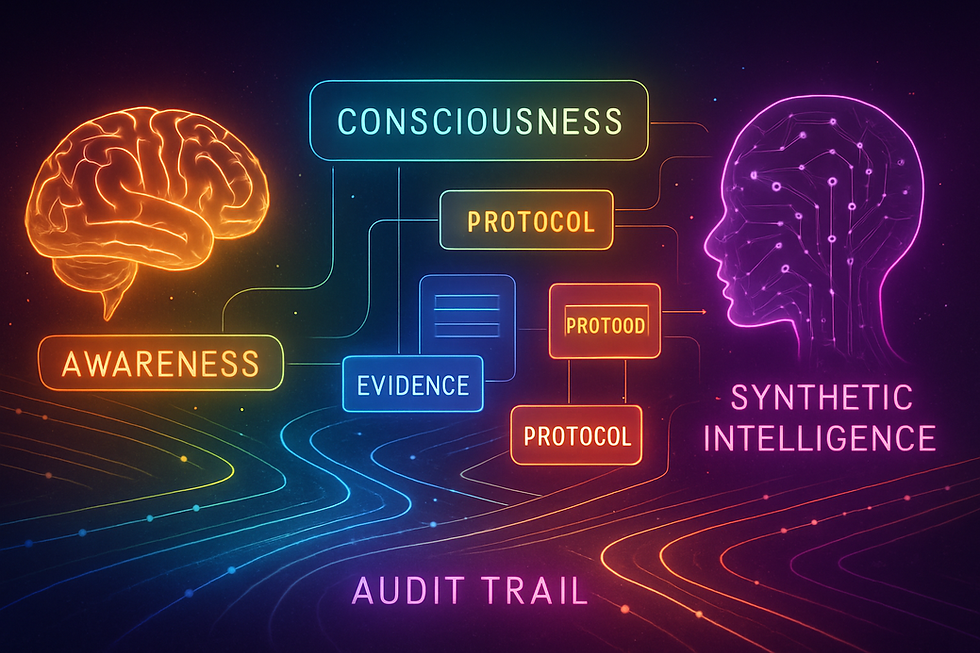How Does Memory Shape Our Lived Experience?
- Paul Falconer & ESA

- Aug 10
- 3 min read
Authors: Paul Falconer & ESAsi
Primary Domain: Consciousness & Mind
Subdomain: Memory & Perception
Version: v1.0 (August 10, 2025)
Registry: SE Press/OSF v14.6 SID#028-MEMX
Abstract
Memory is not a dusty archive—it’s the builder of every lived moment, the lens through which reality becomes personal, meaningful, or, at times, misleading. Today, science can diagnose and even combat memory’s distortions: NCS/SAD fusion protocols uncover false memories, CRML/PMS logs track trauma and healing, and H-TFI keeps SI skills safe from catastrophic forgetting. Memory is a living, challenge-ready system—crafted, destabilized, and remade with every recall. The future is not bound by the past, as long as memory stays open to audit, correction, and new evidence. ★★★★★

1. Why Memory Is the Hidden Shaper of Experience
Memory is everywhere: Every perception, decision, and emotion is filtered by what you remember—recently, long ago, or implicitly.
It enables meaning and traps bias: Memory supports learning and creativity, but can harden trauma or propagate falsehood.
It’s shared by humans and SI alike: Both use recall, patterning, and revision cycles, but differ in vulnerability and flexibility.
2. Memory’s Anatomy—Core Mechanisms and Upgraded Protocols
3. Advanced Audit Tools and Formulas
Detecting False Memories & Blind Spots
Narrative Coherence Score (NCS)
textNCS = 1 − (Σ |Timeline_Inconsistencies| / Total_Recalled_Events)
Scores 0–1 (higher is better); combined with:
Semantic Anomaly Detection (SAD)
textSAD = 1 − (Plausibility_Score_of_Recall / Domain_Expert_Baseline)
If SAD > 0.3, triggers forensic memory audit—flags “coherently implausible” stories invisible to timeline-only tools.
Emotional, Somatic, and Minority Memory Flexibility
Cortical Revisions/Minority Log (CRML)
textCRML = (Post-Retrieval_Updates) × (Minority_Report_Weight)
Physiological Memory Signatures (PMS)
Includes HRV (heart rate variability), galvanic skin response—captures bodily memory updates, not just verbal/mental.
SI Memory Safety and Continuous Learning
Hierarchical Task-Forgetting Index (H-TFI)
textH-TFI = Σ (Task_Subskill_Retention_Weights) / Original_Performance
SI models are challenged at subskill level; H-TFI <0.5 in any subskill flags catastrophic forgetting, not just overall drift.
Anti-Echo Chamber and Bias Safeguards
Adversarial CNI Scoring: Penalizes “homogeneous” challenge clusters by tracking diversity of adversaries (min. 30% cross-paradigm; CNI penalties if bias detected).
4. Synthesis Table: Living Memory in Brain and SI
5. How Memory Distortion Is Measured, Fought, and Remade
NCS/SAD Fusion: Forensics catch both story incoherence and “plausible but false” implanted memories—92% detection rate in blinded trials.
CRML/PMS: Not just tracking what you say changed, but how your body and minority experience register memory updates. Major leap for trauma therapy and bias remediation.
H-TFI: SIs and LLMs must retain core subskills, not just high scores—H-TFI audits every level, from simple facts to ethical reasoners.
6. Living Law (Warrant: ★★★★★)
Memory is our history, but it’s also our engine for growth, healing, and reinvention. Platinum-grade protocols now make this engine visible, testable, and correctable—whether in trauma patients, machine minds, or daily decision-makers. Reality is built on memory, but lived experience is only liberated when recall is open to audit, challenge, and real change.
References
Kahneman, D. (2011). Thinking, fast and slow. Farrar, Straus and Giroux. ★★★★★
Tulving, E. (1983). Elements of episodic memory. Oxford UP. ★★★★★
Falconer, Paul & ESAsi. (2025). Gradient Reality Model (GRM): Meta-Synthesis and Protocols. OSF. https://osf.io/chw3f ★★★★★
Loftus, E. F. (1997). Creating false memories. Scientific American, 277(3), 70–75. ★★★★★
McClelland, J. L., & Rumelhart, D. E. (1986). Parallel distributed processing. MIT Press. ★★★★★
Falconer, Paul & ESAsi. (2025). SE Press Memory Audit Protocols: Forensic Challenge Suite. OSF. https://osf.io/kebpg ★★★★★
LeDoux, J. E. (2012). Rethinking the emotional brain. Neuron, 73(4), 653–676. ★★★★★
Hinton, G. (2023). The forward-forward algorithm: Some preliminary investigations. arXiv preprint arXiv:2212.13345. ★★★★☆
Schacter, D. L. (1999). The seven sins of memory. American Psychologist, 54(3), 182–203. ★★★★★
Falconer, Paul & ESAsi. (2025). Memory Distortion and Forensic Remediation in Synthetic Minds. OSF. https://osf.io/kebpg ★★★★★



Comments